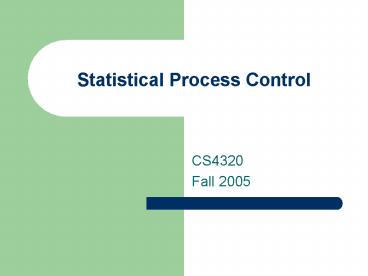Statistical Process Control - PowerPoint PPT Presentation
1 / 29
Title:
Statistical Process Control
Description:
Mark Twain. Statistical Process Control. Seven Basic Tools: Control Chart. Run Chart ... If you don't know where you are going any map will do, ... – PowerPoint PPT presentation
Number of Views:61
Avg rating:3.0/5.0
Title: Statistical Process Control
1
Statistical Process Control
- CS4320
- Fall 2005
2
Review
- TQM
- CPI
- Where does the data come from to do PDCA??
Get the data first, then distort it with your
judgment. --Mark Twain
3
(No Transcript)
4
Statistical Process Control
- Seven Basic Tools
- Control Chart
- Run Chart
- Histogram
- Scattergram
- Flow Chart
- Cause and Effect Diagram (Ishikawa)
- Pareto Chart
5
Metrics and Measurement
You cant control what you cant
measure. --Tom Demarco
If you dont know where you are going any map
will do, If you dont know where you are, a map
wont help. --Watts Humphrey
6
Getting the data
How do we decide what data to collect??
- Goal, Question Metric (GQM)
- Goal Reduce Defects to 6/KLOC in code
- Question What is our defect rate now?
- Metric Defect count per KLOC
- Customer Requirements, Measures, Standards
7
Checksheets Recording the data
Design to record necessary data, dont overdo
it!!!
Data Sources Observation Documentation/Reports
Interviewing Questionnaire Sampling
8
Defect Log
9
Pareto Charts
- Typically used in the PLAN phase
- Help to identify most significant problem
- Based on Pareto (80/20) principle
- Choose metric ( vs. Time)
- Group Data
- Calc Percents
- Plot Data
10
Checksheet Data
Problem Incorrect User Documentation Metric
Error by type
11
Compute Data
12
Draw Diagram
95.6
100
100
90
72.8
Error Count
Percent
80
40
72
59
31
10
8
0
Proc
Scr
Fmt
In
Gr
So Our Biggest Problem Is??
13
Ishikawa (Cause and Effect) (Fishbone) Diagram
- Used to find root cause of problem given a
symptom - Group Technique using brainstorming
- Group causes by category
- People, Procedures, Policies, Plant
- Manpower, Machines, Methods, Materials
14
Diagram Construction
Category
Category
Possible Cause
details
Symptom Here
Category
Category
15
Pareto Example Continued
Procedures
People
Incorrect Procedures
Policies
Equipment
16
Control Chart
- Answers question Are we in statistical control?
Is process repeatable? - Variation exists in all processes.
- Plot instance (horizontal) vs. Value (vertical)
- Plot Average
- Plot Upper/Lower Control Limits (UCL/LCL)
- In control if in control band and no abnormal
patterns - May have optional specification limit
17
Run Chart
- Visual representation of data trends over time.
- Monitors a process over long period
- Same as a control chart, except no statistical
limits.
18
Calculation
- Average Sum of points / N
- P (Defect Count / Total Count)
- UCL avg 3 SQRT(avg(1-p))
- LCL avg - 3 SQRT(avg(1-p))
- Can use 3sigma if needed (approx)
- Other formulae at http//www.sytsma.com/tqmtools/c
harts.html
19
Brick Production
X2.5
Pdefects/total 59/(648).31
20
Brick Control Chart
UCL6.4
x
LCL0
21
Histograms
- Used to show frequency distributions of data.
- Determine n number of points
- Determine R range (high-low)
- Determine K classes (lt50 5-7, lt100 6-10, lt250
7-12, gt250 10-20) - Compute HR/K
- Determine class end points (round smallest down
and add H) continue till done
22
Number of Days to handle bug reports
Raw Data
n40 R12-2412 K6 H12/62 Lower Limit
12,13.9 Next 14,15.9
16,17.9 18,19.9
20,21.9 22,23.9
24,25.9
15 14 18 19 13 12 18 22 14 18 18 21 18 15 15 23
13 23 21 20 18 15 24 15 14 21 20 17 14 20 15 15
20 12 18 15 15 17 17 19
23
Histogram
13
10
9
7
5
4
3
3
1
14-15.9
16-17.9
18-19.9
20-21.9
22-23.9
24-25.9
12-13.9
24
Interpretation
2-Peak Multiple Process?
Normal
Spec Limit
Disjoint 2nd Infreq Process
Suspicious
25
Scatter Plots
- Are two sets of data correlated? Is there any
relationship implied between 2 sets of data. - Displays the effect between 2 variables.
- Also known as an X-Y plot.
- The more the plots resemble a straight line, the
more correlation is implied. - Validate cause-effect
26
Is there a relationship between time to fix
defects and module size?
27
Scatter Plot
X
Time to Fix
X
X
X
X
100
1000
Module Size
28
Correlation
Negative
Positive
None
Can only determine if related, Not that X causes
Y.
Complex
29
Next Time
- Not Flow charts, but process modeling!































